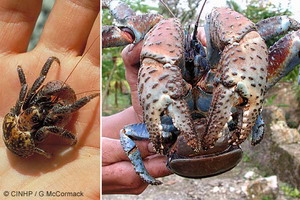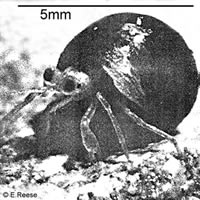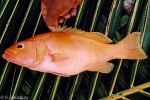Cook Islands Natural Heritage Articles
The Young Coconut Crab
Is it true that hermit-crabs develop into Coconut Crabs?
 The Coconut Crab (Birgus latro) is the world's largest land-crab, often reaching 5kg. They take 7-12 years to reach sexual maturity, and can live more than 50 years. They are nocturnal omnivores, with a preference for coconut meat. Traditional names for large Coconut Crabs include: Unga, Unga Kaveu, Ūngākave‘u, Kaveu, Unga Koveu, and Unga Puku‘ara. Names for smaller ones include Toromimi and Unga ‘Onu.
The Coconut Crab (Birgus latro) is the world's largest land-crab, often reaching 5kg. They take 7-12 years to reach sexual maturity, and can live more than 50 years. They are nocturnal omnivores, with a preference for coconut meat. Traditional names for large Coconut Crabs include: Unga, Unga Kaveu, Ūngākave‘u, Kaveu, Unga Koveu, and Unga Puku‘ara. Names for smaller ones include Toromimi and Unga ‘Onu.
Adult Coconut Crabs usually live within a few hundred metres of the shore, although they sometimes wander inland more than a kilometre. Years ago I met a large blue one on the summit of Mount ‘Ikurangi (485m elevation and about 2.5km from the shore).
Coconut Crabs are usually blue although some are dull orange-red. The colour is not related to age or sex.
Their slow growth to maturity and clumsy evasive action make them easy prey for people. Nowadays they flourish only where they are difficult to harvest, as on remote unpeopled islands, islets, and makatea.
During the summer, mature male and female Coconut Crabs migrate to live near a beach. On the beach, the males transfer their sperm to receptive females in small sperm-sacs. A week later the females move into the water to release 50,000-to-150,000 eggs that immediately hatch into swimming-larvae.
 Most of the larvae are eaten by predators or die of starvation. When the few survivors are a month old they swim back to the shoreline and transform into walking-larvae (=glaucothoe). These minute walkers, about 5mm long, protect themselves with a tiny shellfish shell and start migrating up the beach. Two months later, when they are three months old, they develop into tiny hermit-crabs protected by a more rugged shellfish shell, and they live above the high tide line. As they grow they exchange the protective shell for a larger one. When they are two to three years old, and still less than 2cm long, they abandon the shell, harden their skin, and transform into a miniature of the adult Coconut Crab, with a Thoracic Length of 5-10mm (as in the photograph).
Most of the larvae are eaten by predators or die of starvation. When the few survivors are a month old they swim back to the shoreline and transform into walking-larvae (=glaucothoe). These minute walkers, about 5mm long, protect themselves with a tiny shellfish shell and start migrating up the beach. Two months later, when they are three months old, they develop into tiny hermit-crabs protected by a more rugged shellfish shell, and they live above the high tide line. As they grow they exchange the protective shell for a larger one. When they are two to three years old, and still less than 2cm long, they abandon the shell, harden their skin, and transform into a miniature of the adult Coconut Crab, with a Thoracic Length of 5-10mm (as in the photograph).
Although some of the tiny white hermit-crabs, up to 2cm long, seen on the shore and above the high tide mark might be young Coconut Crabs, the vast majority are the young of our five terrestrial hermit-crabs. The young of these land-hermits go though similar stages to the young Coconut Crab - the difference being that they never outgrow the need of a protective shellfish shell. When they are adults they are usually found in turban or cat’s-eye shells (Ariri) of various sizes. They never turn into Coconut Crabs. Names for these large red, brown and purple hermit-crabs include: Unga, Unga Kute, Unga Kura, Unga Para, Unga Ka‘atea, Unga Kerekere, and Unga Pūtua.
It is therefore true that Coconut Crabs do go through a stage of being tiny white hermit-crabs, although they abandon this mode of life before they are 2cm long. All hermit-crabs over 2cm long are real land-hermits and they never transform into Coconut Crabs.
About Gerald McCormack
 Gerald McCormack has worked for the Cook Islands Government since 1980. In 1990 he became the director and researcher for the Cook Islands Natural Heritage Project - a Trust since 1999.
He is the lead developer of the Biodiversity Database, which is based on information from local and overseas experts, fieldwork and library research. He is an accomplished photographer.
Gerald McCormack has worked for the Cook Islands Government since 1980. In 1990 he became the director and researcher for the Cook Islands Natural Heritage Project - a Trust since 1999.
He is the lead developer of the Biodiversity Database, which is based on information from local and overseas experts, fieldwork and library research. He is an accomplished photographer.
Citation Information
McCormack, Gerald (2005) The Young Coconut Crab. Cook Islands Natural Heritage Trust, Rarotonga. Online at http://cookislands.bishopmuseum.org. ![]()
Please refer to our use policy
